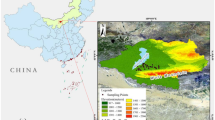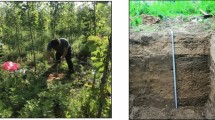Abstract
Soil reconstruction is at the core of mine land reclamation. Reconstructed soil from an opencast mine dump in a loess area is a complex composite that was assembled by humans, using multiple reconstruction technologies. The soil is composed of varied soil particles with irregular shapes and has self-similar structure. To better quantify the characterization of reconstructed soil in this dump, the soil particle-size distribution from four modes of soil reconstruction in the Shanxi Pingshuo Antaibao opencast coal-mine dump was analyzed using multi-fractal theory. Soil reconstruction modes included loess material containing gravel (LG), loess material containing coal gangue (CG), total loess material (AL) and loess material containing ginger stone (LGS). Soil particle composition, gravel content, field water capacity, soil bulk density, soil organic matter, total nitrogen (TN), soil pH and electrical conductivity (EC) of different soil layers from different reconstruction modes were measured. A generalized dimension spectrum D(q), multi-fractal singularity exponent α(q) and multi-fractal spectrum function f(α(q)) were calculated. Relationships between soil properties and fractal parameters were analyzed. The results led to the following conclusions: (1) the soil particle distribution of reconstructed soil had significant multi-fractal characteristics in an opencast coal-mine dump in a loess area. D(0), D(1), D(1)/D(0), Δα and Δf can reflect the non-uniform particle-size distribution characteristics. D(0), D(1)/D(0) and Δf (or D(0), D(1)/D(0) and Δα) can be simplified as three parameters to quantify the multi-fractal characterization of the reconstructed soil particle distribution. (2) After reclamation, the soil quality from different layers of different profiles in different reconstruction modes shows some improvement. (3) There were strong correlations between multi-fractal parameters and soil properties. D(1) and Δα increased and D(1)/D(0) and Δf decreased with increasing gravel content, soil bulk density, organic matter, TN and soil EC; however, it was opposite for pH and field water capacity. Gangue and gravel have a definite impact on the dispersion degree of soil particles in reconstruction. This study provides a theoretical basis for land reclamation and quantitative expression of reconstructed soil particles’ distribution in opencast coal-mine dumps in loess areas.












Similar content being viewed by others
References
Alday J, Marrs R, Martinez-Ruiz C (2011) Vegetation succession on reclaimed coal wastes in Spain: the influence of soil and environmental factors. Appl Veg Sci 14(1):84–94. doi:10.1111/j.1654-109X.2010.01104.x
Bao N, Ye B, Bai Z (2012) Rehabilitation of vegetation mapping of ATB opencast coal-mine based on GIS and RS. Sens Lett 10(1–2):387–393. doi:10.1166/sl.2012.1895
Baveye P, Boast C (1998) Concepts of “fractals” in soil science: demixing apples and oranges. Soil Sci Soc Am J 62(5):1469–1470
Bi R, Bai Z, Li H, Shao H, Li W, Ye B (2010) Establishing a clean-quality indicator system for evaluating reclaimed land in the Antaibao opencast mine area, China. Clean Soil Air Water 38(8):719–725. doi:10.1002/clen.200900232
Bird N, Diaz M, Saa A, Tarquis A (2006) Fractal and multifractal analysis of pore-scale images of soil. J Hydrol 322(1–4):211–219. doi:10.1016/j.jhydrol.2005.02.039
Boruvka L, Kozak J, Muhlhanselova M, Donatova H, Nikodem A, Nemecek K, Drabek O (2012) Effect of covering with natural topsoil as a reclamation measure on brown-coal mining dumpsites. J Geochem Explor 113:118–123. doi:10.1016/j.gexplo.2011.11.004
Caniego F, Martin M, San Jose F (2003) Renyi dimensions of soil pore size distribution. Geoderma 112(3–4):205–216. doi:10.1016/S0016-7061(02)00307-5
Caniego F, Espejo R, Martin M, San Jose F (2005) Multifractal scaling of soil spatial variability. Ecol Model 182(3–4):291–303. doi:10.1016/j.ecolmodel.2004.04.014
Caniego J, Ibanez J, Martinez F (2006) Selfsimilarity of pedotaxa distributions at the planetary scale: a multifractal approach. Geoderma 134(3–4):306–317. doi:10.1016/j.geoderma.2006.03.007
Chauhan S, Ganguly A (2011) Standardizing rehabilitation protocol using vegetation cover for bauxite waste (red mud) in eastern India. Ecol Eng 37(3):504–510. doi:10.1016/j.ecoleng.2010.12.017
Chaulya S, Singh R, Chakraborty M, Dhar B (1999) Numerical modelling of biostabilisation for a coal mine overburden dump slope. Ecol Model 114(2–3):275–286. doi:10.1016/S0304-3800(98)00157-4
Chhabra A, Meneveau C, Jensen R, Sreenivasan K (1989) Direct determination of the f(α) singularity spectrum and its application to fully-developed turbulence. Phys Rev A 40(9):5284–5294. doi:10.1103/PhysRevA.40.5284
Chun H, Gimenez D, Yoon S (2008) Morphology, lacunarity and entropy of intra-aggregate pores: aggregate size and soil management effects. Geoderma 146(1–2):83–93. doi:10.1016/j.geoderma.2008.05.018
Dal Ferro N, Charrier P, Morari F (2013) Dual-scale micro-CT assessment of soil structure in a long-term fertilization experiment. Geoderma 204:84–93. doi:10.1016/j.geoderma.2013.04.012
Dathe A, Tarquis A, Perrier E (2006) Multifractal analysis of the pore- and solid-phases in binary two-dimensional images of natural porous structures. Geoderma 134(3–4):318–326. doi:10.1016/j.geoderma.2006.03.024
Ferreiro J, Vazquez E (2010) Multifractal analysis of Hg pore size distributions in soils with contrasting structural stability. Geoderma 160(1):64–73. doi:10.1016/j.geoderma.2009.11.019
Folorunso O, Puente C, Rolston D, Pinzon J (1994) Statistical and fractal evaluation of the spatial characteristics of soil surface strength. Soil Sci Soc Am J 58(2):284–294
Gibson J, Lin H, Bruns M (2006) A comparison of fractal analytical methods on 2-and 3-dimensional computed tomographic scans of soil aggregates. Geoderma 134(3–4):335–348. doi:10.1016/j.geoderma.2006.03.052
Gimenez D, Perfect E, Rawls W, Pachepsky Y (1997) Fractal models for predicting soil hydraulic properties: a review. Eng Geol 48(3–4):161–183. doi:10.1016/S0013-7952(97)00038-0
Grassberger P (1983) Generalized dimensions of strange attractors. Phys Lett A 97(6):227–230. doi:10.1016/0375-9601(83)90753-3
Grau J, Mendez V, Tarquis A, Diaz M, Saa A (2006) Comparison of gliding box and box-counting methods in soil image analysis. Geoderma 134(3–4):349–359. doi:10.1016/j.geoderma.2006.03.009
Grout H, Tarquis A, Wiesner M (1998) Multifractal analysis of particle size distributions in soil. Environ Sci Technol 32(9):1176–1182. doi:10.1021/es9704343
Guan XY, Yang PL, Ren SM, Li YK (2007) Multifractal analysis of soil structure under long-term wastewater irrigation based on digital image technology. N Z J Agric Res 50(5):789–796
Ibanez J, Ruiz-Ramos M, Tarquis A (2006) Mathematical structures of biological and pedological taxonomies. Geoderma 134(3–4):360–372. doi:10.1016/j.geoderma.2006.03.010
Jimenez-Hornero F, de Rave E, Giraldez J, Laguna A (2009) The influence of the geometry of idealised porous media on the simulated flow velocity: a multifractal description. Geoderma 150(1–2):196–201. doi:10.1016/j.geoderma.2009.02.006
Kirkpatrick L, Weishampel J (2005) Quantifying spatial structure of volumetric neutral models. Ecol Model 186(3):312–325. doi:10.1016/j.ecolmodel.2005.01.056
Li Y, Li M, Horton R (2011) Single and joint multifractal analysis of soil particle size distributions. Pedosphere 21(1):75–83. doi:10.1016/S1002-0160(10)60081-1
Li H, Shao H, Li W, Bi R, Bai Z (2012) Improving soil enzyme activities and related quality properties of reclaimed soil by applying weathered coal in opencast-mining areas of the Chinese Loess Plateau. Clean Soil Air Water 40(3):233–238. doi:10.1002/clen.201000579
Liu X, Zhang G, Heathman G, Wang Y, Huang C (2009) Fractal features of soil particle-size distribution as affected by plant communities in the forested region of Mountain Yimeng, China. Geoderma 154(1–2):123–130. doi:10.1016/j.geoderma.2009.10.005
Martin M (2006) Mathematical modelling of leaching by irregular wetting fronts in chemically heterogeneous porous media. Geoderma 134(3–4):267–273. doi:10.1016/j.geoderma.2006.03.004
Martin M, Montero E (2002) Laser diffraction and multifractal analysis for the characterization of dry soil volume-size distributions. Soil Tillage Res 64(1–2):113–123. doi:10.1016/S0167-1987(01)00249-5
Martinez F, Martin M, Caniego F, Tuller M, Guber A, Pachepsky Y, Garcia-Gutierrez C (2010) Multifractal analysis of discretized X-ray CT images for the characterization of soil macropore structures. Geoderma 156(1–2):32–42. doi:10.1016/j.geoderma.2010.01.004
Miranda J, Montero E, Alves M, Gonzalez A, Vazquez E (2006) Multifractal characterization of saprolite particle-size distributions after topsoil removal. Geoderma 134(3–4):373–385. doi:10.1016/j.geoderma.2006.03.014
Montero E (2005) Renyi dimensions analysis of soil particle-size distributions. Ecol Model 182(3–4):305–315. doi:10.1016/j.ecolmodel.2004.04.007
Montero E, Martin M (2003) Holder spectrum of dry grain volume-size distributions in soil. Geoderma 112(3–4):197–204. doi:10.1016/S0016-7061(02)00306-3
Nikolic N, Nikolic M (2012) Gradient analysis reveals a copper paradox on floodplain soils under long-term pollution by mining waste. Sci Total Environ 425:146–154. doi:10.1016/j.scitotenv.2012.02.076
Pardini G (2003) Fractal scaling of surface roughness in artificially weathered smectite-rich soil regoliths. Geoderma 117(1–2):157–167. doi:10.1016/S0016-7061(03)00164-2
Paz-Ferreiro J, Vazquez E, Miranda J (2010) Assessing soil particle-size distribution on experimental plots with similar texture under different management systems using multifractal parameters. Geoderma 160(1):47–56. doi:10.1016/j.geoderma.2010.02.002
Perfect E, Gentry R, Sukop M, Lawson J (2006) Multifractal Sierpinski carpets: theory and application to upscaling effective saturated hydraulic conductivity. Geoderma 134(3–4):240–252. doi:10.1016/j.geoderma.2006.03.001
Pinuela J, Alvarez A, Andina D, Heck R, Tarquis A (2010) Quantifying a soil pore distribution from 3D images: multifractal spectrum through wavelet approach. Geoderma 155(3–4):203–210. doi:10.1016/j.geoderma.2009.07.007
Posadas A, Gimenez D, Bittelli M, Vaz C, Flury M (2001) Multifractal characterization of soil particle-size distributions. Soil Sci Soc Am J 65(5):1361–1367
Roisin C (2007) A multifractal approach for assessing the structural state of tilled soils. Soil Sci Soc Am J 71(1):15–25. doi:10.2136/sssaj2006.0132
Ruzek L, Vorisek K, Vrablikova J, Strnadova S, Vrablik P (2003) Chemical and biological characteristics of reclaimed soils in the Most region (Czech Republic). Plant Soil Environ 49(8):346–351
Shrestha R, Lal R (2011) Changes in physical and chemical properties of soil after surface mining and reclamation. Geoderma 161(3–4):168–176. doi:10.1016/j.geoderma.2010.12.015
Taguas F, Martin M, Perfect E (1999) Simulation and testing of self-similar structures for soil particle-size distributions using iterated function systems. Geoderma 88(3–4):191–203. doi:10.1016/S0016-7061(98)00104-9
Tyler S, Wheatcraft S (1992) Fractal scaling of soil particle-size distributions—analysis and limitations. Soil Sci Soc Am J 56(2):362–369
Wang D, Fu B, Zhao W, Hu H, Wang Y (2008) Multifractal characteristics of soil particle size distribution under different land-use types on the Loess Plateau, China. Catena 72(1):29–36. doi:10.1016/j.catena.2007.03.019
Wang JM, Liu WH, Yang RX, Zhang L, Ma JJ (2013) Assessment of the potential ecological risk of heavy metals in reclaimed soils at an opencast coal mine. Disaster Adv 6:366–377
Wang J, Zhang M, Bai Z, Yang R, Guo L (2014) Multi-fractal characteristics of reconstructed soil particle in opencast coal mine dump in loess area. Trans Chin Soc Agric Eng 30(4):230–238 (in Chinese)
Zeleke T, Si B (2006) Characterizing scale-dependent spatial relationships between soil properties using multifractal techniques. Geoderma 134(3–4):440–452. doi:10.1016/j.geoderma.2006.03.013
Zhang M, Wang JM, Bai ZK, Liu CL (2012) The topsoil quality variation under different reclamation modes in pasture opencast coal mine of China. In: Iranpour R, Zhao J, Wang A, Yang FL, Li X (eds) Advances in environmental science and engineering, vol 518–523(1–6). Advanced Materials Research, pp 4790–4795. doi:10.4028/www.scientific.net/AMR.518-523.4790
Zhao Z, Bai Z, Zhang Z, Guo D, Li J, Xu Z, Pan Z (2012) Population structure and spatial distributions patterns of 17 years old plantation in a reclaimed spoil of Pingshuo opencast mine, China. Ecol Eng 44:147–151. doi:10.1016/j.ecoleng.2012.03.018
Zhao Z, Shahrour I, Bai Z, Fan W, Feng L, Li H (2013) Soils development in opencast coal mine spoils reclaimed for 1-13 years in the West-Northern Loess Plateau of China. Eur J Soil Biol 55:40–46. doi:10.1016/j.ejsobi.2012.08.006
Acknowledgments
This research was supported by the National Natural Science Foundation of China (41271528), Beijing Higher Education Young Elite Teacher Project, and the Fundamental Research Funds for the Central Universities of China (2652012072).
Author information
Authors and Affiliations
Corresponding author
Rights and permissions
About this article
Cite this article
Wang, J., Zhang, M., Bai, Z. et al. Multi-fractal characteristics of the particle distribution of reconstructed soils and the relationship between soil properties and multi-fractal parameters in an opencast coal-mine dump in a loess area. Environ Earth Sci 73, 4749–4762 (2015). https://doi.org/10.1007/s12665-014-3761-0
Received:
Accepted:
Published:
Issue Date:
DOI: https://doi.org/10.1007/s12665-014-3761-0




